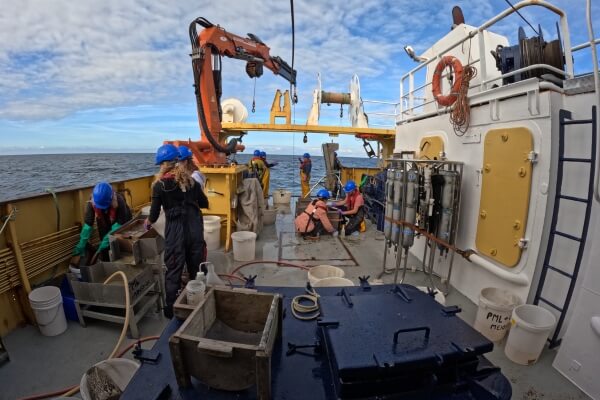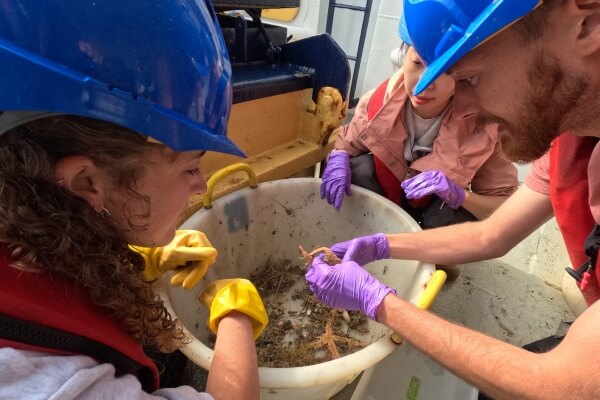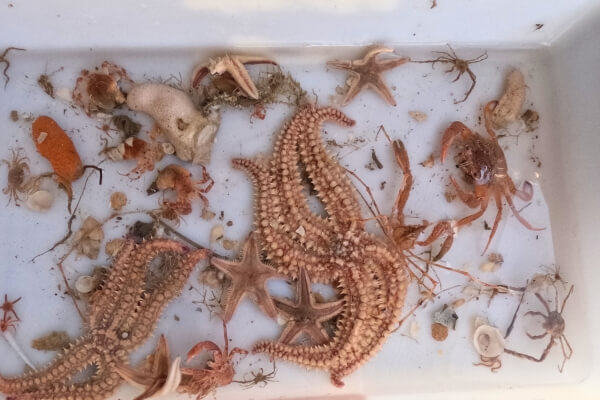WCO Benthic survey
The PML benthic survey is an ongoing ecological time-series. The time-series aims to capture the natural temporal and spatial variability of the marine biological ecosystems encompassed by the Plymouth Sound and contiguous coastal waters. Initiated in 2008 and currently supported by the NERC CLASS programme, the survey is aggregated with the Western Channel Observatory due to the uniqueness and comprehensiveness of the datasets collected. Unique to the UK, the multidisciplinary nature of the benthic survey has created a highly valuable resource for ecosystem management.
Watch a Benthic Survey trip
Monthly benthic biological sampling has been undertaken at a variety of sites within the Plymouth Sound, and currently focuses on the marine biodiversity reference site, station L4. The biodiversity, abundance, and biomass of macrofauna, megafauna, meiofauna and bacterial communities within and on the sediment are determined. The multidisciplinary data collected within the scope of the survey covers a diverse range of habitats to account for a range of physical, biological, and chemical parameters. Every sampling point enables an insight into the different levels of complexity of these ecosystems, the biodiversity and the ecosystem process it sustains. In line with DEFRA's UK Marine Strategy Framework Directive objectives for Good Environmental Status, the benthic survey long-term time-series enables ecologists and modellers to better grasp the spatial and temporal variation of these marine ecosystems by validating environmental models used for management and forecasting of future global ocean changes.
L4 is an exposed site with a depth of approximately 50 m, with sediments ranging from mud to sand. The benthic survey monthly sampling further augments an already exhaustive sampling regime to allow the critical inclusion of the biological components to Bayesian environmental models (e.g. ERSEM). Biological community structure is studied and analysed in parallel to a range of environmental and sediment parameters such as sheer stress, granulometry, redox, CHN, productivity and steroid analysis providing a wholistic ecosystem approach. Reproductive stages of selected macrofauna species have been determined through histology in addition to processes in the marine nitrogen cycle. Since 2009 bimonthly estimates of anammox and denitrification rates have been monitored, as have nutrient fluxes between the sediment and the water column. Other parameters incorporated into the survey include nitrous oxide and methane (greenhouse gases), bioturbation and bioirrigation. Further enriching the comprehensiveness of the long-term time-series the benthic survey continues to develop into the future bringing together aspects of the UN sustainability goals including carbon sequestration involving innovative blue carbon mitigation modelling techniques, cutting edge molecular eDNA methodologies and AI learning using new smart-sound technologies which all aim towards supporting policy development.


In parallel the benthic survey strongly supports PML's priority for training and education and has supported 38 scientific placements since 2008, including student projects, apprenticeships and visiting scientist both nationally and internationally. Annual formal university undergraduate module training and teaching has provided fieldwork experience and introductions to benthic ecology to University of Exeter Marine Ecology undergraduate students. Most recently the benthic survey is well placed to provide strong mutually beneficial avenues and linkages within Marine Research Plymouth moving into the future which all work toward celebrating the South-West as a regional hub of scientific excellence. The benthic survey has supported 24 peer reviewed publications, PhD, MSc projects and biological datasets including reporting to DEFRA to provide the basis of impact assessments following the dockyard dredge disposal activities in Plymouth Sound and impactful cutting edge research concerning blue carbon sequestration.
Publications
- Mesher T., McNeill C.L. (2022). Benthic Survey Macrofauna Abundance and Biomass Data, as part of the Western Channel Observatory, UK, between 2008 and 2019. UK WCO benthic survey macrofauna and biomass data, 2008 - 2019 (bodc.ac.uk)
- Dashfield, S., and McNeill, C.L. (2014). Western English Channel macro and megafauna abundance and biomass (2008 - 2013) doi:10/vq6
- Coppock RL, Lindeque PK, Cole M, Galloway TS, Nakki P, Birgani H, Richards S, Queiros AM (2021) Benthic fauna contribute to microplastic sequestration in coastal sediments. Journal of Hazardous Materials, 415, 125583 doi.org/10.1016/j.jhazmat.2021.125583
- Ruhl S, Thompson CEL, Queiros AM, Widdicombe S (2020) Intra-Annual Patterns in the Benthic-Pelagic Fluxes of Dissolved and Particulate Matter. Frontiers in Marine Science. doi:10.3389/fmars.2020.567193
- Quieros AM, Stephens N, Widdicombe S, Tait K, McCoy SJ, Ingels J, R??hl S, Airs R, Beesley A, Carnovale G, Cazenave P, Dashfield S, Hua E, Jones M, Lindeque P, McNeill CL, Nunes J, Parry H, Pascoe C, Widdicombe C, Smyth T, Atkinson A, Krause-Jensen D, Somerfield PJ (2019) Connected macroalgal-sediment systems: blue carbon and food webs in the deep coastal ocean. Ecological Monographs e01366
- G Lessin, J Bruggeman, CL McNeill, S Widdicombe (2019) Time scales of benthic macrofaunal response to pelagic production differ between major feeding groups. Frontiers in Marine Science 6:15 doi: 10.3389/fmars.2019.00015
 Western Channel Observatory
Western Channel Observatory